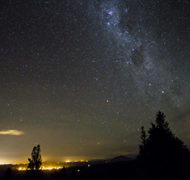Seeing God in the Stars
Blog / Produced by The High Calling
Dr. Jennifer Wiseman is an astronomer, author, and speaker. She has been seeing God in the stars ever since she was a child. As an undergraduate student at the Massachusetts Institute for Technology, she co-discovered the comet 114P/Wiseman-Skiff. As senior project scientist for the Hubble Space Telescope at NASA's Goddard Space Flight Center, she studies star-forming regions of our galaxy using radio, optical, and infrared telescopes. As director of the Dialogue on Science, Ethics, and Religion for the American Association for the Advancement of Science, she helps improve communication between scientists and faith communities. Dr. Wiseman talked to The High Calling about her personal views entwining science, faith, and discovery. The interview has been edited for length and clarity.
The High Calling: Do you view your work as an astronomer as a high calling from God? If so, how?
Jennifer Wiseman: Yes, I view the study of nature as a high calling, because we believe God is responsible for all of creation and that creation itself glorifies God. To learn more about it is in some way learning more about God and being appreciative of his wonderful work.
Because of your expertise in astronomy, you’ve been able to see spiritual implications in the fact that human beings are ultimately made of stardust. Can you describe this for us?
We now understand from astrophysics that all of the elements that make up our bodies and the familiar objects around us (such as carbon, iron, and oxygen) are produced inside stars. In fact, stars are little factories that turn hydrogen and other gasses into these heavier elements, and that’s the only way we know of that these heavier elements are produced. Then these heavier elements get dispersed out into interstellar space where next generations of stars and planets pick them up. So, in some sense we are entirely products of this beautiful process within stars. As a Christian, I can’t think of a more beautiful process for God to have blessed the production of the elements that we need for life than the beauty of stars. In fact, we are told that we shine like stars in the universe. So it’s a nice cycle there.
You’ve said that as you were growing up, your faith was nurtured by the consistency in word and deed of both your parents and your faith community. Why is this kind of consistency so important?
We’re all working to find a way of understanding the world around us that makes some sense in a world that often doesn’t make sense. I found that the loving nurture of my family and church, rooted in the gospel of Christ, fit well with what I observed and experienced, both the good and the bad. The gospel of Christ encompasses the reasons for both the good and beauty around us and also the pain and suffering. It does not ignore or deny the depth of suffering in the world, and so in that sense there is consistency, although there are many things I don’t fully understand.
You’ve also said that in college you didn’t experience the kind of philosophical crisis that some scientists do as a person of faith, but you did find it necessary to re-gauge your understanding of the magnitude of God’s creation. How did this increased understanding impact your faith?
My growing sense of the magnitude of the universe and God’s creation, in space and time and also in complexity, gave me a much deeper sense of appreciation for God. It was also, in some sense, a relief, because trying to cram all the majestic things we were learning from science about nature into a very limited picture of God was not satisfying. The unfathomable grandeur of the universe is much more consistent with the nature of the God that we read about in the Bible. Why wouldn’t a great God create a universe that is enormous in size, beauty, and complexity? It’s also amazing that he’s given us the scientific tools and ability to understand and appreciate it.
When you encounter friends or colleagues who perhaps have grown up in churches that did not support their scientific interests or that presented a conflict between science and faith, how do you advise or encourage them?
Two things are helpful. One is that I myself was blessed in college and graduate school by hearing from Christians who would articulate a range of views that Christ-centered Christians have held about science. Understanding that Christians who share the same faith and the same love of Christ can explore different views on exactly how the Bible and science fit together freed me to be able to realize that my faith in Christ is solid regardless of what science is telling us from one year to the next. And, I can explore and examine different scientific theories without feeling constrained that the Bible teaches only one particular scientific theory, because the Bible really doesn’t give us scientific details about how nature works.
The second thing that’s helpful is for all of us to remind each other that the central tenet of our faith is the person of Jesus Christ. Who he is, what he has accomplished through his death and resurrection, and how we are to respond to that—those are the central tenets of the faith. These other issues, as interesting as they are—the age of the universe, how life developed, whether there is life elsewhere—these kinds of things are not central to our faith.
In an interview with Minnesota Public Radio, you talked about your work as director of the American Association for the Advancement of Science Dialogue on Science, Ethics, and Religion. You said dialogue is meant to help articulate science to religious communities and also to help overcome some of the language barriers between scientists and religious communities. How can lay Christians help ease these tensions?
There are things Christians can do within the Christian community that scientists who are outside the community cannot really address. For most Christians, the real issue is not so much concern over scientific data, although that’s often where the conversation goes. The real issue is: what is it that Scripture is and isn’t telling us about the details of creation and of nature? And so, one way that Christians can help each other—especially those in leadership, pastors and theologians—is to talk about the type of knowledge Scripture is intended to give us. For example, many Christian scholars of the Bible do not believe that the opening verses and chapters of Genesis were ever meant to explain in a scientific way the details of how the universe and life came into being. It was very much a theological passage to tell us that there’s one God and God is responsible for all of creation, that God declared this creation good, and that creation and nature are not to be worshiped. Rather the God who is the creator is to be worshiped. Those are some of the outstanding messages from that passage, whereas trying to glean specific details about time scales and scientific processes was just not something that was intended for that passage, many scholars would say.
The other thing Christians can do is to have a more positive discussion about science within congregations. When I talk about astronomy and other sciences in churches, I find that both adults and children are very excited to learn about what we are discovering with telescopes and microscopes. And why shouldn’t we be? If we believe the God we love is responsible for the grandeur of the universe, there should be nothing but joy in finding out some of the details, even though the experience can startle us from our complacency. Finding out some of the mind-blowing details of how nature works should give us a sense of excitement and should be something the church encourages.
In Elaine Howard Ecklund’s book, Science vs. Religion: What Scientists Really Think, she said young Christian scientists sometimes perceive resistance to their faith in the scientific community. As a woman and as a person of faith, how have you navigated those challenges or have you not experienced them?
For Christians early in their careers, it’s often most important to concentrate on learning the trade and establishing a good foundation of expertise in the specific field of study. That in itself, if it’s truly a calling, is glorifying to God. It’s often, in some sense, better to wait until later in one’s career to start talking about some of the other aspects of one’s life publicly. But that can be different for each person.
Certainly our faith isn’t something to keep private. I don’t believe in that. I believe our faith is personal, but not private. But young scientists often feel a lot of competing pressures as they try to establish a scientific career—trying to get research published, trying to earn tenure if they’re at a university—and then also wondering if they should be more active in their church or more outspoken about their faith. That can be almost too much. They should consider their scientific research a real part of their service and worship to God. That in itself is glorifying to God and then if opportunities grow, especially later on, they can become more of a spokesperson for explaining their faith to others. It doesn’t all have to come right at the beginning.
We would be remiss if we didn’t ask you about your current research. What are you working on right now that you’re most excited about?
I’m doing research with radio telescopes in which we are finding baby stars at their very earliest stage of formation. These proto-stars are basically condensed clumps of gas in interstellar space that are heating up and accreting more and more dense gas until eventually there will be enough material for the gravitational pressure of this clump of gas to cause it to basically turn on as a shining star. We’re seeing them before they’ve turned on and seeing interesting features about these infant stars. I find that to be very exciting.
Have you seen any actually turn on?
That’s a process that takes many, many thousands of years, so we don’t get to watch it in that sense, but we do get to see different baby stars in different stages. And so, we can put together the whole juvenile portrait of stars as they form. We also see interesting effects as these baby stars go through these formative stages. For example, we see some of the in-falling material—that is, the material falling onto the star through gravitational attraction—get ejected out because of magnetic fields around the young star. It produces fabulous exhaust jets that project into space around the baby star. That we can see in real time and it’s quite spectacular.
Image by Jason Brown. Used with permission. Sourced via Flickr. Post by Christine A. Scheller.





